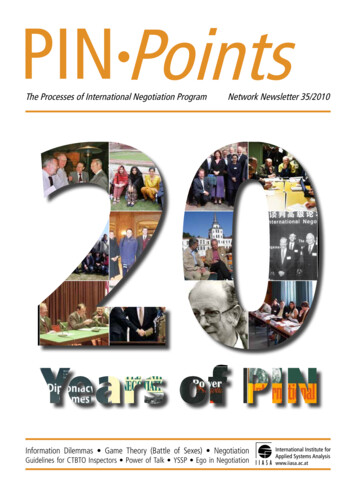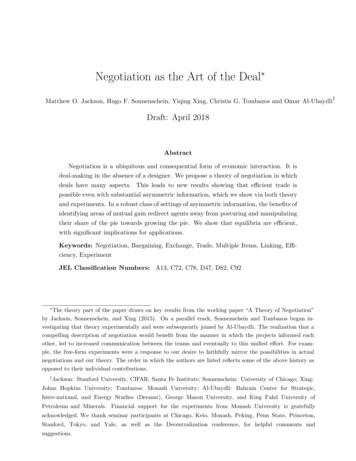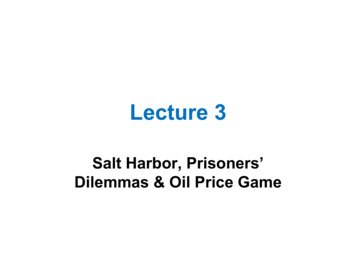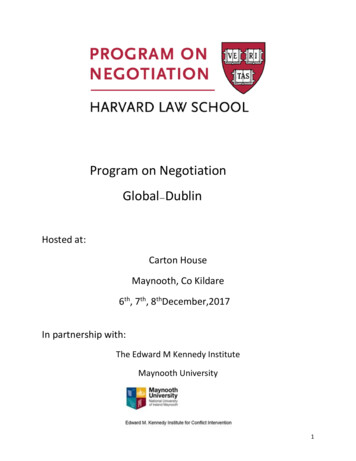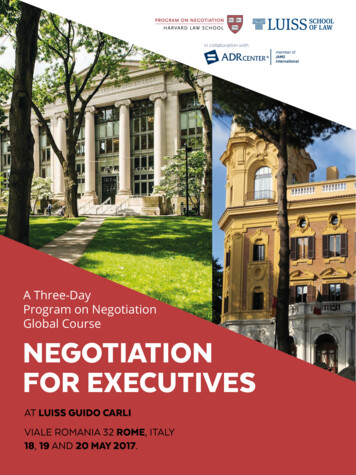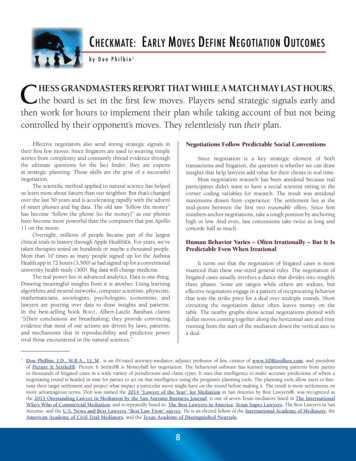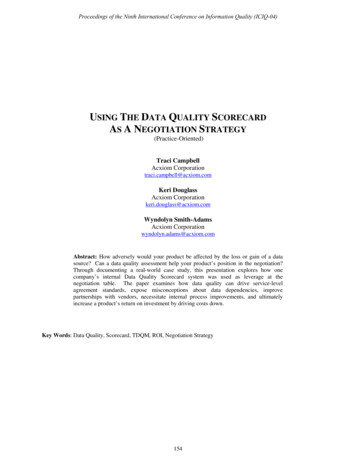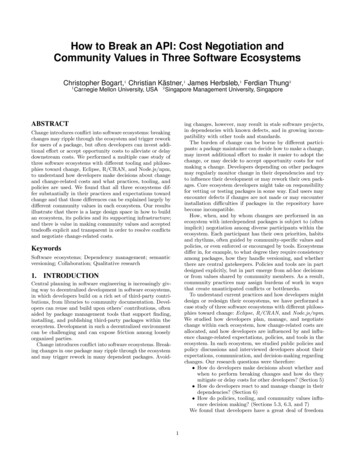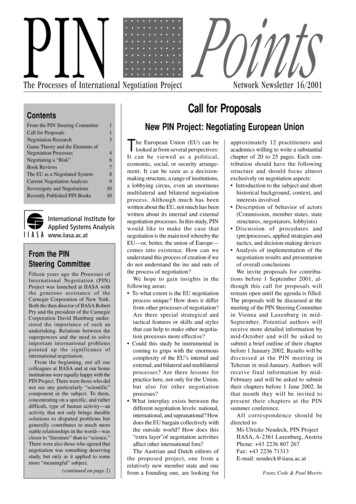
Transcription
The Processes of International Negotiation ProjectCall for ProposalsContentsFrom the PIN Steering CommitteeCall for ProposalsNegotiation ResearchGame Theory and the Elements ofNegotiation ProcessesNegotiating a “Risk”Book ReviewsThe EU as a Negotiated SystemCurrent Negotiation AnalysisSovereignty and NegotiationsRecently Published PIN BooksNetwork Newsletter 16/2001113467891010From the PINSteering CommitteeFifteen years ago the Processes ofInternational Negotiation (PIN)Project was launched at IIASA withthe generous assistance of theCarnegie Corporation of New York.Both the then director of IIASA RobertPry and the president of the CarnegieCorporation David Hamburg understood the importance of such anundertaking. Relations between thesuperpowers and the need to solveimportant international problemspointed up the significance ofinternational negotiation.From the beginning, not all ourcolleagues at IIASA and at our homeinstitutions were equally happy with thePIN Project. There were those who didnot see any particularly “scientific”component in the subject. To them,concentrating on a specific, and ratherdifficult, type of human activity—anactivity that not only brings durablesolutions to disputed problems butgenerally contributes to much morestable relationships in the world—wascloser to “literature” than to “science.”There were also those who agreed thatnegotiation was something deservingstudy, but only as it applied to somemore “meaningful” subject.(continued on page 2)New PIN Project: Negotiating European UnionThe European Union (EU) can belooked at from several perspectives:It can be viewed as a political,economic, social, or security arrangement. It can be seen as a decisionmaking structure, a range of institutions,a lobbying circus, even an enormousmultilateral and bilateral negotiationprocess. Although much has beenwritten about the EU, not much has beenwritten about its internal and externalnegotiation processes. In this study, PINwould like to make the case thatnegotiation is the main tool whereby theEU—or, better, the union of Europe—comes into existence. How can weunderstand this process of creation if wedo not understand the ins and outs ofthe process of negotiation?We hope to gain insights in thefollowing areas: To what extent is the EU negotiationprocess unique? How does it differfrom other processes of negotiation?Are there special strategical andtactical features or skills and stylesthat can help to make other negotiation processes more effective? Could this study be instrumental incoming to grips with the enormouscomplexity of the EU’s internal andexternal, and bilateral and multilateralprocesses? Are there lessons forpractice here, not only for the Union,but also for other negotiationprocesses? What interplay exists between thedifferent negotiation levels: national,international, and supranational? Howdoes the EU bargain collectively withthe outside world? How does this“extra layer”of negotiation activitiesaffect other international fora?The Austrian and Dutch editors ofthe proposed project, one from arelatively new member state and onefrom a founding one, are looking forapproximately 12 practitioners andacademics willing to write a substantialchapter of 20 to 25 pages. Each contribution should have the followingstructure and should focus almostexclusively on negotiation aspects: Introduction to the subject and shorthistorical background, context, andinterests involved Description of behavior of actors(Commission, member states, statestructures, negotiators, lobbyists) Discussion of procedures and(pre)processes, applied strategies andtactics, and decision-making devices Analysis of implementation of thenegotiation results and presentationof overall conclusionsWe invite proposals for contributions before 1 September 2001, although this call for proposals willremain open until the agenda is filled.The proposals will be discussed at themeeting of the PIN Steering Committeein Vienna and Laxenburg in midSeptember. Potential authors willreceive more detailed information bymid-October and will be asked tosubmit a brief outline of their chapterbefore 1 January 2002. Results will bediscussed at the PIN meeting inTeheran in mid-January. Authors willreceive final information by midFebruary and will be asked to submittheir chapters before 1 June 2002. Inthat month they will be invited topresent their chapters at the PINsummer conference.All correspondence should bedirected toMs Ulricke Neudeck, PIN ProjectIIASA, A-2361 Laxenburg, AustriaPhone: 43 2236 807 267Fax: 43 2236 71313E-mail: neudeck@iiasa.ac.atFranz Cede & Paul Meerts
2Despite this skepticism concerninginternational negotiation, the PIN groupwent ahead. It was a propitious time forstarting a research project on international negotiation for several reasons.First, PIN emerged at a time when anend to the Cold War was becoming a realpossibility. Because of the nature ofIIASA, scientists at the Institute wereaccustomed to working under conditionsof confrontation between the superpowers. But at this time, there was astrong hope that the conflict of the ColdWar might be replaced with partnership.International negotiation was badlyneeded both to end the confrontation andto achieve a state of cooperation.Second, works by people such asH. Raiffa, R. Fisher, W. Ury, I.W.Zartman, J. Rubin, and many others hadmade the subject of negotiation—international negotiation in particular—fashionable and relevant. Around thesame time that the PIN Project wasestablished, the Program on Negotiationwas started up at Harvard University,bringing Harvard researchers togetherwith scientists from Tufts University andthe Massachusetts Institute of Technology(MIT). During this same period, publications on negotiation appeared in theSoviet Union, Germany, France, andSweden.Third, as the possibility of negotiablesolutions lost its abstract nature andacquired a practical dimension, it becameevident that people in the real worldknew very little of the negotiating stylesand behaviors of people from othercultures, of the changes in decisionmaking processes, and of the possibilitiesof working together and sharing the samevalues and approaches. The “real world”wanted to know more.The PIN network responded activelyto all these challenges, and at each stageof its research it has worked to make itsresults available to wider audiences. Thefollowing is a partial list of topicsinvestigated by PIN researchers and theresulting publications: Identification of the people interestedin the subject of negotiation and theirinitial contributions (Processes ofInternational Negotiations, F. MautnerMarkhof, ed., 1989, Westview Press) An analysis of the state of the art ofnegotiation and an identification offuture research agendas (InternationalNegotiation: Analysis, Approaches,Issues, V.A., Kremenyuk, ed., 1991,Jossey-Bass, Inc.) Preliminary attempts to outline thearea of research through identificationof its “neighbors,” such as culture(Culture and Negotiation, G.O. Faure andJ.Z. Rubin, eds, 1993, Sage Publications)and power (Power and Negotiation, I.W.Zartman and J.Z. Rubin, eds, 2000,University of Michigan Press) Outline of some important areas ofnegotiation, including the environment(International Environmental Negotiation, G. Sjöstedt, ed., 1993, SagePublications) and trade and finance(International Economic Negotiation.Models versus Reality, V.A. Kremenyukand G. Sjöstedt, eds, 2000, Edward ElgarPublishing) Negotiations aimed at specific targets,including preventive negotiation(Preventive Negotiation, I.W. Zartman,ed., 2000, Rowman and LittlefieldPublishers, Inc.) and negotiationconcerning regime building (NegotiatingInternational Regimes: Lessons Learnedfrom the United Nations Conference onEnvironment and Development (UNCED),B.I. Spector, G. Sjöstedt, and I.W.Zartman, eds, 1994, Graham & TrotmanLimited) Analysis of multilateral negotiations(International Multilateral Negotiation:Approaches to the Management ofComplexity, I.W. Zartman, ed., 1994,Jossey-Bass, Inc.)The choice of topics for specific bookprojects may seem somewhat random. Inreality, the PIN group started by workingon topics that were at the surface. Theanalysis of the state of the art of negotiationrevealed a number of unstudied topics andmissed opportunities that demandedattention. And the PIN Project followed thelogic of these findings.To date, nine monographs have beenpublished by the PIN network, and fivemore are in the pipeline. This alone is animpressive achievement. Add to this thePINPoints newsletter sent around the globeto thousands of readers, PIN’s annual “roadshows” throughout the world, and the manycourses and seminars carried out at home.All considered, PIN has made a sizablecontribution to negotiation studies.But this is only the beginning. A muchmore difficult and promising phase liesahead. Even with the many topics alreadycovered by PIN, there are still untouchedareas of study. And the fifteenth anniversaryof the PIN network is a good occasion tothink about the future.First of all, the problem of a negotiablecomponent of international problems—anaddendum to proposed solutions, whichmay constitute recommendations onagendas, participants, and possible (ordesirable) outcomes of negotiations—hasnot even been touched upon. It is logicalto expect that people working on modelsin areas such as food and water supplies,transboundary effects of air and waterpollution, risk management, etc., wouldwelcome the opportunity to transformtheir technical findings into the languageof diplomats and international organizations. Without negotiation, even the mostbrilliant solution to an internationalproblem is simply a piece of abstractthinking.Second, computers are breaking downthe doors of negotiation. The Internet hasturned global communications intoglobal bargaining: people negotiate,make deals and purchases, discuss issues,and exchange concessions via the Internet. Understanding how this expansionof negotiation affects the traditionalidentification of negotiation and whatchanges in the process, structure, andstrategies it may introduce will be animportant challenge in the near future.Third, the growing assessment of negotiation as a decision-making procedurehas not yet been studied in depth. Thismay invite a thorough reevaluation of therelevance of mathematical approaches tothe study of negotiation, a reintroductionof game-theoretical elements, and otherconsequences of the same type andmagnitude.Fourth, it is high time to translateresults of negotiation research intotextbooks and other auxiliary materialsfor students, diplomats, businessexecutives, international civil servants,and others exposed to negotiation.One can also think of new works onlegal aspects of negotiation, economiccontent, negotiation at the regional andlocal levels, and many other useful andpromising areas.Thus, an agenda for negotiationresearch is something to approachseriously and in a systematic way.Perhaps special meetings should be heldbetween PIN and PON (the Program onNegotiation at Harvard), and betweenIIASA’s PIN group and the PIN groupsin Germany, France, Finland, theNetherlands, and China. “Negotiate onnegotiations” may very easily becomethe motto of the next stage of negotiationresearch.Rudolf AvenhausFranz CedeGuy Olivier FaureVictor A. KremenyukPaul MeertsGunnar SjöstedtI. William Zartman
3Negotiation ResearchA Neglected Support for the Development of Strategies of Conflict PreventionIn recent years, increasing efforts havebeen made by the European Union(EU) to develop a viable capacity forpreventing conflict in its “close surroundings”—in fact, a vast area ofland. To the east and south this areaextends from the republics of theformer Soviet Union through theIndian Ocean into the Middle East. Itcovers large parts of Africa andstretches into the waters and islandsof the South Atlantic. There is a general belief that successful conflictprevention early in an escalationprocess is less costly than interventionin the form of crisis managementundertaken to stop erupting or ongoingopen hostilities. As it grows increasingly difficult for the EU and itsmember states to isolate themselvesfrom conflicts in these “close surroundings,” the value of preparedpolicies for conflict prevention isgrowing steadily. This is an importantmotive for the current interest in conflict prevention in the EU institutionsthat are particularly concerned withforeign and security policy.However, as Anders Bjuvner, theSwedish representative to the EUInterim Political and Security Committee, has observed, “much remains tobe done to make prevention reallyhappen” (Truedson, 2000:23). Thus, anaim of the policy process in the EUconcerning conflict prevention is tosystematically build capacity in thisarea in the context of a long-termstrategy. Some measures have beenhighlighted in this regard, such as thoseto improve the effectiveness of theEU’s early warning system for conflicts, those to increase the number ofpolicy instruments at the EU’s disposal,and those to generally adapt EUcontrolled resources to fit into astrategy of conflict prevention.The approach of building prevention capacity in the EU has certainlymade some progress during the pastfew years. As a process, it has beenclosely linked to the continuousdevelopment of instruments andinstitutions for military (and civilian)crisis management, as well as to thegeneral reinforcement of the EU’ssecurity policy. For example, generalaims and policy guidelines have beenarticulated and lists of policy instruments have been identified, analyzed,acknowledged, and established in theEU’s policy processes. However,looking at these developments fromthe perspective of a social scientist, afew ideas come to mind as to howprocess knowledge in the area ofinternational negotiation, for example,might be employed to support theattempts to enhance the EU’s capacityfor conflict prevention.The debate and related policyconsiderations in the EU systemconcerning
made the subject of negotiation— international negotiation in particular— fashionable and relevant. Around the same time that the PIN Project was established, the Program on Negotiation was started up at Harvard University, bringing Harvard researchers together with scientists from Tufts University and the Massachusetts Institute of .
